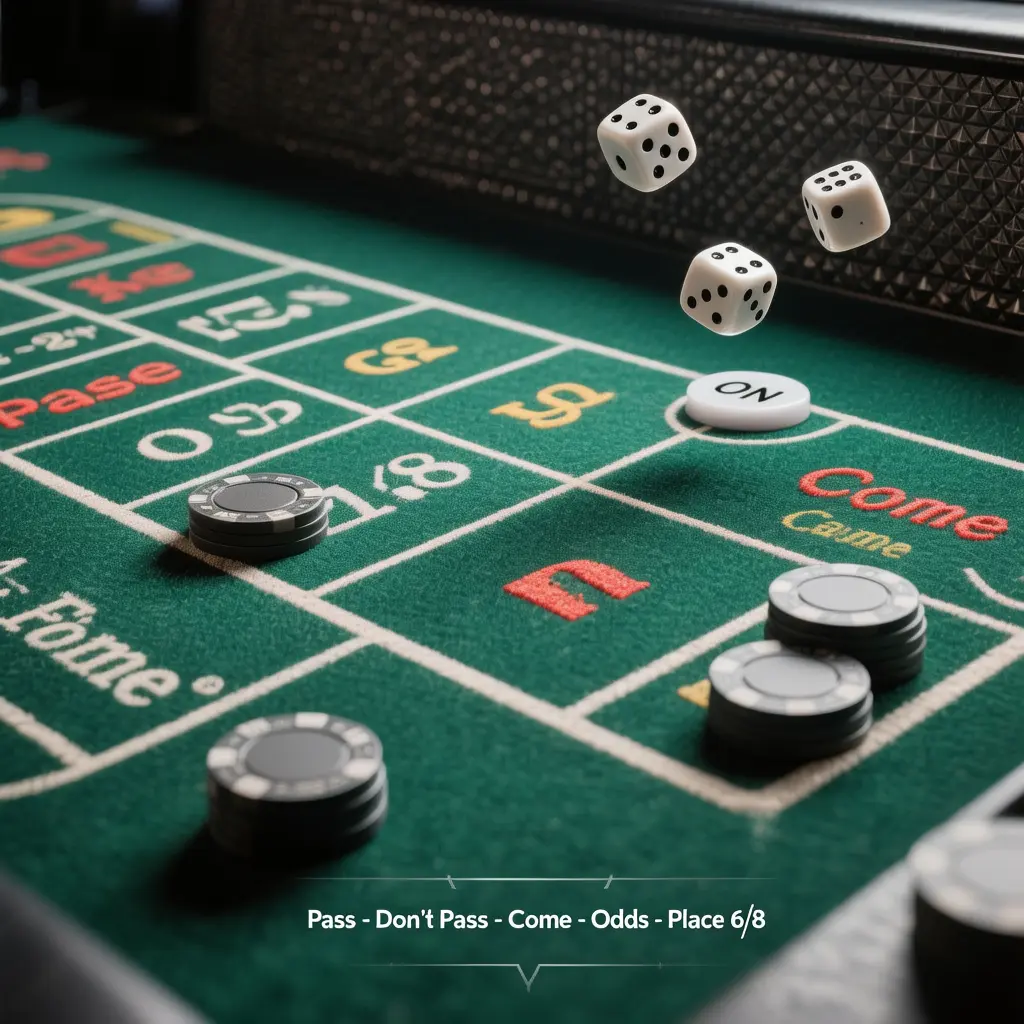Welcome to the ultimate craps guide for beginners and aspiring pros. The roar of the crowd, the rattle of dice, the shared thrill of a hot shooter—craps is undeniably the most energetic game in any casino.
But its complex-looking table and rapid-fire slang can be intimidating. Fear not. This guide breaks down everything you need to know, from the basic pass line bet explained to smart bankroll management.
By the end, you’ll be ready to step up to the table with confidence, understand the flow of the game, and make the smartest bets to maximize your fun and your chances of winning.
What is Craps? The Excitement of the Dice
At its heart, craps is a simple dice game where players bet on the outcome of a pair of dice rolled by one player, known as the “shooter.” All players at the table bet on the same roll, creating a unique sense of camaraderie you won’t find at a slot machine or blackjack table. The game is played in rounds, with players taking turns being the shooter. While it seems complicated, you only need to learn craps rules for a few key bets to get started and enjoy the action.

Decoding the Craps Guide: Understanding the Table Layout for Beginners
The first thing that overwhelms new players is the craps table layout for beginners. It looks like a chaotic mess of numbers and strange phrases. But once you understand its logic, it becomes much clearer. A standard craps table is a long tub-like structure managed by a crew of four casino employees: the Boxman, two Base Dealers, and the Stickman.
The layout is mirrored on both ends, so players on either side have the same betting options. These two identical sections are the “wings.” The center section is where the Stickman manages the high-risk, high-reward proposition bets.
- The Wings: This is where most of the action happens for beginners. You’ll find the most important bets here: the Pass Line, Don’t Pass bar, Come, Don’t Come, Field Bets, and the large boxes for Place Bets on the numbers 4, 5, 6, 8, 9, and 10.
- The Center: This area contains the “sucker bets” with a high house edge, like the Hardways bets explained later, and one-roll bets on specific numbers like Any Seven or Any Craps. While tempting, beginners should generally avoid this area.
The Two Phases of Craps: The Come-Out Roll and The Point
Every round of craps is broken into two distinct phases. Understanding this is fundamental to learning the game.
Phase One: The Come-Out Roll
This is the first roll of a new round. You’ll know it’s a come-out roll because the dealer’s puck (a small disc) will be on its “OFF” side. The shooter rolls the dice, and one of three things can happen:
- Natural (7 or 11): All bets on the Pass Line win instantly. The round is over, and a new come-out roll begins.
- Craps (2, 3, or 12): All bets on the Pass Line lose. The round is over, and a new come-out roll begins. (Note: The shooter doesn’t necessarily lose the dice unless a “seven out” occurs).
- Point (4, 5, 6, 8, 9, or 10): The number rolled becomes the “point.” The dealer flips the puck to its “ON” side and places it on that number on the layout. The game now moves to Phase Two.
Phase Two: The Point is Established
Once a point number is set, the shooter’s goal is to roll that same point number again before rolling a 7.
- If the shooter rolls the point number again, Pass Line bets win. The round ends, the puck is turned “OFF,” and a new come-out roll starts.
- If the shooter rolls a 7 (known as a “seven out“), Pass Line bets lose. The round ends, the dice are passed to the next player for a new shooter rotation, and the game starts over with a come-out roll.
A Beginner’s Craps Guide to the Safest Bets with the Lowest Edge
As a beginner, your goal is to stay in the game, have fun, and make smart wagers. The safest craps bets with lowest edge are the fundamental bets on the table. You can play for hours just by sticking to these.
The Pass Line Bet Explained: Your Gateway to Craps
The Pass Line bet is the most popular and fundamental bet in craps. It’s a multi-roll bet where you’re betting *with* the shooter. The house edge craps on this bet is a low 1.41%.
- On the Come-Out Roll: You win if the shooter rolls a 7 or 11. You lose if they roll a 2, 3, or 12.
- Once a Point is Established: You win if the shooter rolls the point number again before rolling a 7. You lose if a 7 comes first.
This bet pays even money (1:1). If you only learn one bet, make it this one.
The Don’t Pass Bet: Betting Against the Shooter
The Don’;t Pass bet is the opposite of the Pass Line. You’re betting *against* the shooter. It has a slightly lower house edge of 1.36%, making the pass vs don’t pass house edge comparison very close.
- On the Come-Out Roll: You win if the shooter rolls a 2 or 3. You lose on a 7 or 11. A 12 is a “push” (a tie), where you neither win nor lose. This push on 12 is what gives the house its edge.
- Once a Point is Established: You win if the shooter rolls a 7 before rolling the point number. You lose if the point is rolled first.
A Note on “Wrong” Betting
Players betting the Don’t Pass are often called “wrong” bettors because they win when most of the table loses. While it’s a perfectly valid and smart bet, it’s considered good etiquette to keep your celebrations quiet if you win on a seven out.
The Come Bet Explained: A Game Within a Game
The Come Bet is exactly like a Pass Line bet, but you make it *after* a point has been established. When you place a chip in the Come area, the very next roll acts as a personal come-out roll for your bet.
- If the next roll is a 7 or 11, your Come bet wins immediately.
- If it’s a 2, 3, or 12, your Come bet loses.
- If it’s any other number (4, 5, 6, 8, 9, 10), that number becomes your personal “;Come Point.” The dealer will move your chip to that number’s box. Your bet now wins if your Come Point is rolled again before a 7.
The come vs don’t come debate is similar to Pass vs. Don’t Pass; it’s about betting with or against the dice on a mid-game roll.
The Smartest Bet in the Casino: The Odds Bet Explained
This is the most important part of any good craps guide. The Odds Bet is a secondary bet you can make after a Pass, Don’t Pass, or Come bet has a point established. What makes it so special? It has zero house edge. The casino makes no money on this bet, which is why they limit how much you can wager on it. It pays at true odds.
How Odds Bets Work in Craps
To make an odds bet, you simply place your chips behind your original Pass Line bet once a point is established. The casino will allow you to bet a multiple of your original bet, often advertised as “3-4-5x Odds.”
- 3-4-5x Odds Multiple Explained: This means you can bet up to 3 times your Pass Line bet on points of 4 and 10, 4 times on points of 5 and 9, and 5 times on points of 6 and 8.
The payouts for taking odds are:
| Point Number | True Odds | Payout for a $10 Odds Bet |
|---|---|---|
| 4 or 10 | 2 to 1 | $20 |
| 5 or 9 | 3 to 2 | $15 |
| 6 or 8 | 6 to 5 | $12 |
Always, always back your Pass/Come bets with the maximum odds you can afford. It is the best bet you can make in any casino.
Beyond the Basics: A Craps Guide to Place, Field, and Buy Bets
Once you’re comfortable with the basic bets, you can explore other wagers to add more action.
Place Bets Explained: Betting on Specific Numbers
A Place Bet is a simple wager that a specific number (4, 5, 6, 8, 9, or 10) will be rolled before a 7. You can make or remove this bet at any time after the come-out roll. The house edge is lowest on Place 6 and Place 8 (1.52%), making them very popular bets.
- Place 6 or 8: Pays 7 to 6. (Bet in multiples of $6 to get a proper payout).
- Place 5 or 9: Pays 7 to 5.
- Place 4 or 10: Pays 9 to 5.
The Field Bet Explained: A One-Roll Wager
The Field Bet is a one-roll bet that the next roll will be a 2, 3, 4, 9, 10, 11, or 12. It’s a self-service bet, meaning you can place your own chips in the large “;FIELD” area. It pays even money (1:1) for most numbers, but often pays double (2:1) on a 2 and triple (3:1) on a 12. While it offers instant gratification, the house edge is higher (starting at 2.78%), so veteran players often avoid it.
Place vs Buy Bets Explained (and Lay Bets)
A Buy Bet is similar to a Place Bet, but you pay a 5% commission (or “vig”) upfront to get paid at true odds if the number hits. This is only advantageous on the 4 and 10, as it lowers the house edge compared to a Place Bet on those numbers. A Lay Bet is the opposite: you bet that a 7 will roll *before* a specific number, and you also pay a commission to get true odds.
The Center of the Table: Proposition Bets Explained
The center of the table is home to high-risk, high-payout one-roll bets called Proposition Bets. These are managed by the stickman and generally have a very high house edge. While they can be fun for a small thrill, they are not part of a winning long-term strategy.
- Hardways Bets Explained: A bet that a 4, 6, 8, or 10 will be rolled “the hard way” (as a pair: 2-2, 3-3, 4-4, 5-5) before it’s rolled the “easy way” or a 7 is rolled. For example, a Hard 6 (3-3) wins, but an “easy” 6 (5-1 or 4-2) or a 7 loses.
- Any Craps: A one-roll bet that the next roll will be a 2, 3, or 12.
- Any Seven: A one-roll bet that the next roll will be a 7.
- Yo Eleven: A one-roll bet on 11. Players shout “Yo!” to avoid confusion with “seven.”
Craps Etiquette – The Unwritten Rules of the Table
Knowing the rules is one thing, but knowing how to act is what makes you look like a pro. Craps has a rich culture of etiquette and superstition. Ignoring it can earn you dirty looks from other players and the dealers.
Your Craps Guide to Table Etiquette
- Joining a Table: The best time to buy in is when the puck is “OFF” (during a come-out roll or between shooters). Avoid throwing your money down mid-roll, as it’s considered bad luck and disrupts the game’s flow. Find an open spot and wait for a break in the action.
- Handling the Dice: When it’s your turn to shoot, use only one hand to pick up and roll the dice. Keep the dice over the table and in view at all times. Aim for the back wall at the opposite end of the table to ensure a fair roll.
- Placing Bets: Place your self-service bets (like Pass Line and Field) directly in front of you. For dealer-assisted bets (like Place or Buy bets), get the dealer’s attention, place your chips in the Come area, and clearly state your desired bet (e.g., “Place the 6 and 8 for $12 each”).
- Keep Your Hands Out: Once the shooter has the dice, keep your hands out of the table area. A flying die hitting your hand is a major foul. This is often called the “tub.”
- Don’;t Say the “S” Word: Superstitious players believe saying the word “seven” at the table is bad luck when a point is established. If you must bet on it, call it “Big Red.”
- Respect the Dealers and Players: Dealers work hard to manage a fast-paced game. Be clear with your bets and patient during payouts. Be courteous to other players, even “wrong” bettors. The camaraderie is part of the fun.
- Coloring Up: When you’re ready to leave, wait for the puck to be “OFF.” Stack your chips neatly in front of you and ask the dealer to “color up.” They will exchange your smaller denomination chips for larger ones, making them easier to carry and cash out.
Bankroll for Craps Sessions: A Smart Betting Strategy
Perhaps the most critical part of any craps guide is money management. Without a plan, even a hot streak can end in a busted bankroll. The key is discipline and having a clear strategy.
How Much Money Do You Need?
A common rule of thumb is to have a session bankroll that is at least 20 times your standard betting unit. For a $10 minimum table, if your typical bet on the Pass Line is $10, you should bring at least $200 to the table for that session.
- Calculate Your Session Bankroll: (Table Minimum Bet) x (Number of Bets You Want to Sustain) = Session Bankroll. For a one-hour session, planning for 20-30 bets is a safe approach.
Set Win Goals and Loss Limits
Discipline is everything. Before you even place your first bet, decide on two numbers:
- Win Goal: A realistic target, such as winning 20-50% of your session stake. If you buy in for $200 and hit $300, consider coloring up and walking away a winner.
- Loss Limit: The absolute maximum you are willing to lose. A common limit is 50% of your session stake. If your $200 drops to $100, it’s time to take a break. Never chase your losses.
Beginner Craps Betting Strategy
The best craps strategy for a beginner is simple, minimizes the house edge, and keeps you in the game.
- Start with a Pass Line bet.
- If a point is established, take the maximum Odds bet you can afford. This is your core strategy.
- (Optional) Once comfortable, add one or two Come bets, also backed with full odds.
- (Alternative) Instead of Come bets, make Place bets on the 6 and 8. These numbers have the highest probability of being rolled after the 7.
Pro Tip: The Disciplined Player
A winning craps player isn’t necessarily the one who knows the most complex bets. It’s the one with the discipline to stick to a smart strategy, manage their bankroll effectively, and walk away at the right time—whether they’re up or down.
Frequently Asked Questions (FAQs)
Q1. What is the absolute best bet in craps for a beginner?
The single best bet is the Pass Line bet backed with a full Odds bet. The Pass Line has a low house edge (1.41%), and the Odds bet has zero house edge, bringing the combined edge down significantly. It’s simple to understand and follows the main flow of the game.
Q2. Why do people say not to bet in the middle of the craps table?
The middle of the table contains the proposition bets, which are almost all one-roll bets with extremely high house edges (often over 10%). While they offer big, flashy payouts, they are statistically the worst bets on the table and will drain your bankroll quickly. They are often called “sucker bets” for this reason.
Q3. What does “3-4-5x Odds” mean?
This refers to the maximum amount you can wager on your Odds bet, relative to your Pass Line or Come bet. It means you can bet up to 3x your original bet on points 4 and 10, 4x on points 5 and 9, and 5x on points 6 and 8. This structure makes the math easier for dealers, as a winning odds bet will always pay out 6x your original Pass Line wager.
Q4. Can I bet on craps if I am not the shooter?
Yes, absolutely! All players at the table can (and do) bet on every roll made by the shooter. You are only required to make a bet (on the Pass or Don’t Pass line) if you are the shooter.
Q5. What is the difference between a Place bet and a Buy bet?
A Place bet pays out at casino odds, which are slightly less than the true odds. A Buy bet requires you to pay a 5% commission (vig) to the house, and in return, you are paid at true odds if you win. A Buy bet is only a better value than a Place bet on the numbers 4 and 10.
Q6. What happens if the dice fly off the table?
If one or both dice leave the table, the roll is invalid (“no roll”). The stickman will call for the same dice or introduce a new set, and the shooter will roll again. It’s a common occurrence and simply pauses the game for a moment.
Q7. How much money should I bring to a $5 craps table?
A good starting bankroll for a $5 minimum table is between $100 and $200 for a single session. This gives you 20-40x the table minimum, which should be enough to withstand some variance and play for a reasonable amount of time using a basic strategy like Pass Line with Odds.
Q8. What is a “seven out”?
A “seven out” is when the shooter rolls a 7 *after* a point has been established. This results in a loss for all Pass Line and Come bets. When a seven out occurs, the round ends, and the dice are passed to the next player to become the new shooter.
This comprehensive craps guide was written on behalf of Anilg by an iGaming expert with over 20 years of experience at the tables. Play smart, stay disciplined, and enjoy the game!
With over 20 years of experience in the iGaming industry, Anilgnews provides expert analysis and in-depth content to help players and operators navigate the complexities of online gambling regulation.




